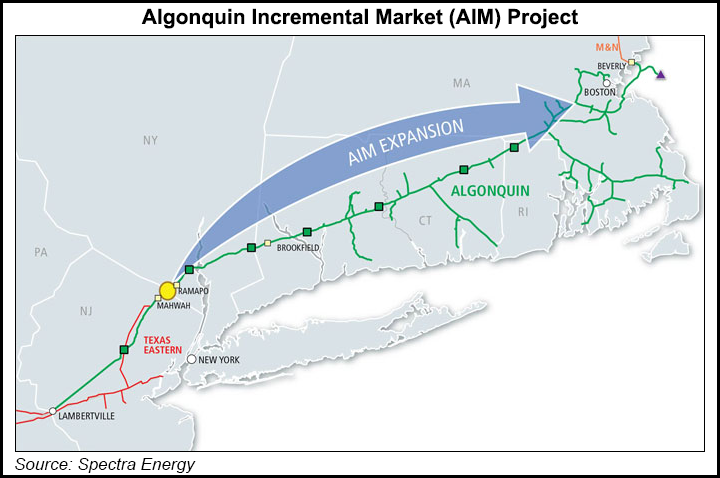NGI Archives | NGI All News Access
New England States Looking to Further Expansions of Algonquin
A nonprofit organization that represents the six New England states on regional electricity issues has asked FERC to conduct an expanded analysis of Algonquin Gas Transmission’s Incremental Market (AIM) expansion project to encompass potential further expansions in the future.

In a letter Friday to the Federal Energy Regulatory Commission (FERC), New England States Committee on Electricity (NESCOE) Executive Director Heather Hunt said NESCOE agreed with the position of the Connecticut Department of Energy & Environmental Protection (DEEP), which had asked for a modified National Environmental Policy Act (NEPA) review of the project.
Specifically, DEEP had submitted comments that Spectra Energy Corp., Algonquin’s parent, had originally planned for the AIM Project (Docket No. PF13-16) to provide 500,000 Dth/d of gas transportation capacity into New England (see Daily GPI, Oct. 15). The project was scaled back after Spectra held an open season, but DEEP said they were concerned that another pipeline project would be needed in a few years, regardless.
“In addition to review of the AIM Project at its proposed project size, consistent with DEEP’s request, the commission should undertake a concurrent analysis that assumes a materially larger project,” Hunt said, adding that NESCOE “understands that Spectra disagrees with such an approach, stating in response to DEEP’s request that FERC’s review should ‘not include an analysis of speculative future Algonquin projects.’
“While [we appreciate] Spectra’s desire to limit the scope of NEPA analysis, this requested modification would not displace the review sought by Spectra. Rather, it would add to this analysis through a complementary, parallel study. Such an enhanced study is timely and efficient, taking into account potential solutions to an increasing dependence on natural gas-fired generation and regional state collaboration specific to the development of natural gas pipeline.”
The AIM Project, in its current form, would provide an additional 342,000 Dth/d of gas from the Marcellus and Utica shales to New York, Connecticut, Rhode Island and Massachusetts (see Shale Daily, Oct. 25).
The project calls for replacement of 19.6 miles of 26-inch diameter pipeline with 42-inch diameter pipe in New York and Connecticut; a 2.1-mile extension of an existing pipeline loop in Connecticut; replacement of about 9.1 miles of 6-inch diameter pipeline with 16-inch diameter pipe in Connecticut; about 1.4 miles of new 12-inch diameter looping pipeline in Connecticut (the E-1 System Loop), and installation of 4.8 miles of new lateral pipeline in Massachusetts (the West Roxbury Lateral).
About 78% of the pipeline infrastructure for the project will replace existing pipelines, while the remainder will consist of new pipeline loops and one lateral.
Also included in the project is an additional 72,240 horsepower of compression at five existing stations, new metering and regulating (M&R) stations in Connecticut and Massachusetts, and modifications to existing M&R stations in New York, Connecticut and Massachusetts.
The project is expected to be in service in November 2016. Construction is expected to begin during 1Q2015 and be completed by October 2016.
© 2024 Natural Gas Intelligence. All rights reserved.
ISSN © 1532-1231 | ISSN © 2577-9877 |
